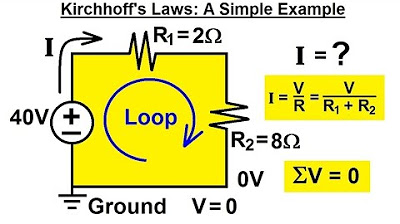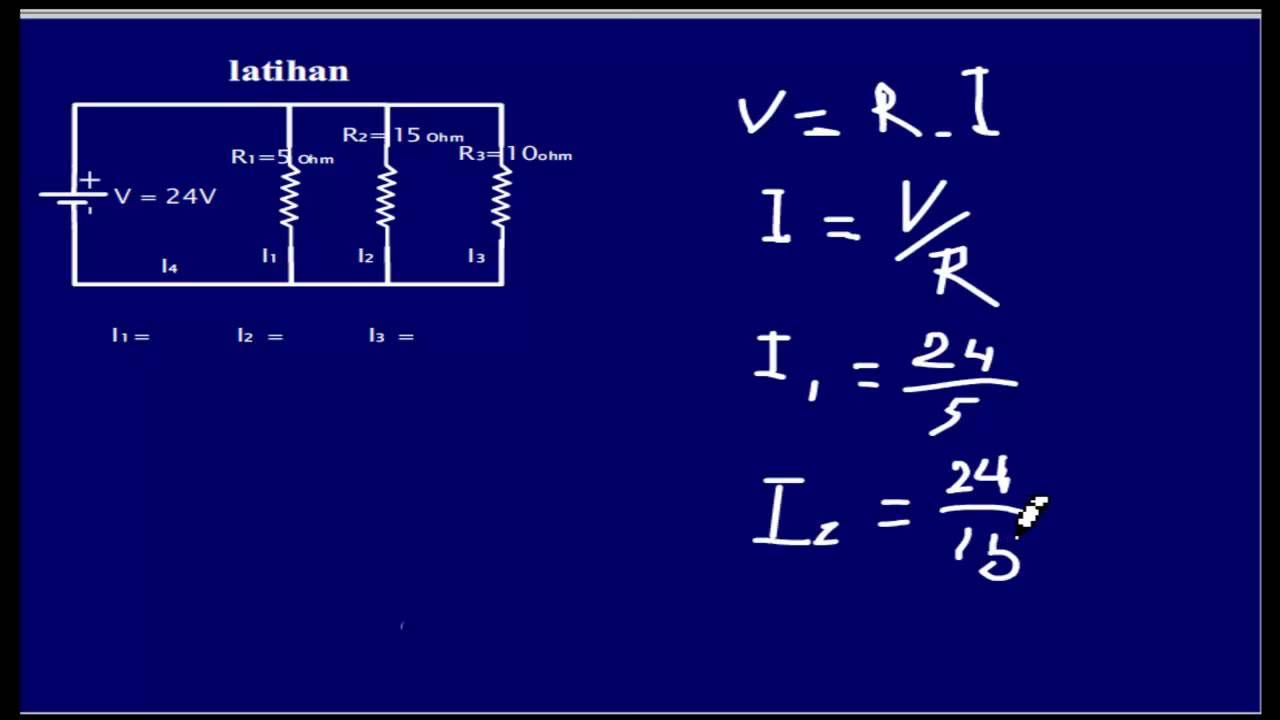KVL and KCL Examples (Circuits for Beginners #12)
Summary
TLDRThis video explains the application of Kirchhoff’s Voltage Law (KVL) and Kirchhoff’s Current Law (KCL) to analyze electrical circuits. It covers three examples: finding the voltage across a 10-ohm resistor, analyzing a circuit with a diode, and solving a complex network of resistors. The video emphasizes the importance of using KVL and KCL to simplify circuit analysis, especially when dealing with nonlinear components like diodes or complex resistor networks. Through step-by-step problem-solving, it illustrates how these laws help calculate unknown voltages and currents, making circuit analysis more manageable.
Takeaways
- ⚡ Kirchhoff’s Voltage Law (KVL) states that the sum of voltage rises and drops around any closed loop in a circuit must equal zero.
- 🔁 Kirchhoff’s Current Law (KCL) states that the total current entering a node must equal the total current leaving that node.
- 🔋 In the first example, the 10V source defines the voltage across the 10-ohm resistor in the circuit.
- 📘 Applying KVL around the outer loop allows calculation of unknown voltages and currents in the circuit.
- 🔧 Ohm’s Law (V = IR) is used to relate voltage, current, and resistance — but only applies to resistors.
- 🚫 A diode is a nonlinear component, so V = IR does not apply; it requires different equations to describe its behavior.
- 🔗 Components directly connected by wires share the same voltage, meaning they are in parallel and have equal potential difference.
- 🔍 By combining KVL and KCL, unknown currents and voltages (like I and V) can be systematically determined through substitution and algebraic manipulation.
- 💡 The current through the diode in the second example is calculated to be 0.8A after applying both Kirchhoff laws and Ohm’s Law to related elements.
- 🧩 In complex resistor networks, KCL can simplify analysis by treating multiple nodes or elements as a single ‘supernode’.
- ✅ The supernode concept helps easily find unknown currents without solving large simultaneous equations, as shown when determining I = 0.6A.
- 🎓 The video emphasizes understanding when and how to apply Kirchhoff’s Laws and Ohm’s Law correctly to simplify circuit analysis problems.
Q & A
What is Kirchhoff's Voltage Law (KVL)?
-Kirchhoff's Voltage Law states that the sum of the electrical potential differences (voltage) around any closed loop or circuit is always zero. This is due to the conservation of energy.
How is Kirchhoff's Voltage Law applied in the first example involving the 10 ohm resistor?
-In the first example, Kirchhoff's Voltage Law is applied to the outermost loop of the circuit, starting from the 12V source. By summing the voltages, including the voltage drops across resistors, the voltage across the 10 ohm resistor is determined.
Why can't the relationship V = IR be used for a diode in the second example?
-The equation V = IR is specific to resistors, as resistors follow a linear relationship between voltage and current. A diode, being a non-linear element, does not obey this relationship. Therefore, a different approach must be used to determine the current and voltage across the diode.
How does Kirchhoff's Current Law (KCL) help in analyzing the circuit in the second example with the diode?
-Kirchhoff's Current Law is used to determine the current flowing through the diode. The current at a node is conserved, meaning the current entering the node equals the current leaving it. This principle helps in calculating the unknown current through the diode.
What role does Ohm's Law play in finding the voltage across the resistor in Example 2?
-Ohm's Law is used to calculate the voltage across the resistor, where the current and resistance are known. This allows the voltage across the resistor (V_R) to be found, which then helps in determining the voltage across the diode.
How is the current through the diode determined in Example 2?
-The current through the diode is determined by using Kirchhoff's Voltage Law along with Kirchhoff's Current Law. The voltage across the diode and the resistor is calculated, and then the current is solved using the equations formed from these laws.
What is the significance of the 10V source in Example 2 when analyzing the diode?
-The 10V source influences the voltage across the components in the circuit, including the diode. It is crucial in applying Kirchhoff's Voltage Law to form equations that allow for the determination of the current through the diode.
How can Kirchhoff's Current Law simplify the analysis of more complex circuits, as seen in Example 3?
-In Example 3, Kirchhoff's Current Law helps simplify the analysis by treating a collection of circuit elements as a 'supernode.' This allows us to use the total current entering and leaving the supernode to find the unknown current, instead of analyzing individual components.
What is a 'supernode' in the context of Kirchhoff's Current Law?
-A supernode is a combination of multiple circuit elements connected together in such a way that the current entering and leaving the group must be the same. This concept allows for simplification when dealing with complex circuits.
How does the application of Kirchhoff's Current Law simplify the circuit in Example 3 with nine resistors?
-By applying Kirchhoff's Current Law to the supernode, the problem is simplified. Instead of solving for the currents through each individual resistor, the total current flowing into the node is used to find the current coming out of the node, reducing the complexity of the problem.
Outlines

Cette section est réservée aux utilisateurs payants. Améliorez votre compte pour accéder à cette section.
Améliorer maintenantMindmap

Cette section est réservée aux utilisateurs payants. Améliorez votre compte pour accéder à cette section.
Améliorer maintenantKeywords

Cette section est réservée aux utilisateurs payants. Améliorez votre compte pour accéder à cette section.
Améliorer maintenantHighlights

Cette section est réservée aux utilisateurs payants. Améliorez votre compte pour accéder à cette section.
Améliorer maintenantTranscripts

Cette section est réservée aux utilisateurs payants. Améliorez votre compte pour accéder à cette section.
Améliorer maintenantVoir Plus de Vidéos Connexes

Electrical Engineering: Basic Laws (9 of 31) Kirchhoff's Laws: A Simple Example

CURRENT MIRROR AND LEVEL SHIFTING

Kirchhoff's Current Law (KCL) Explained

KVL and KCL (Circuits for Beginners #11)

Kirchhoff's Laws - How to Solve a KCL & KVL Problem - Circuit Analysis

Elektronika Dasar 002 Resistor 02 Universitas Jember
5.0 / 5 (0 votes)
